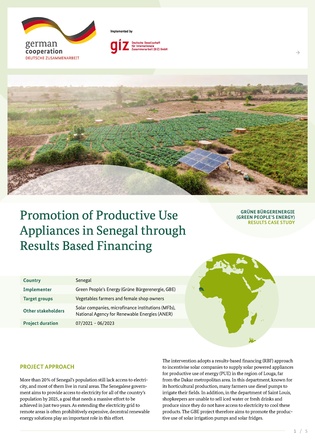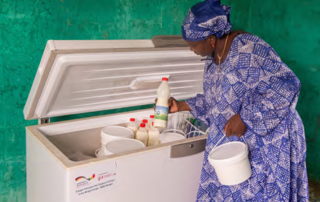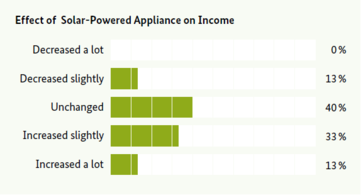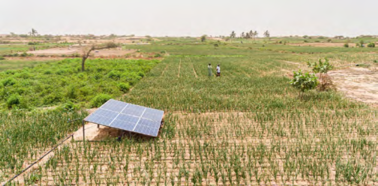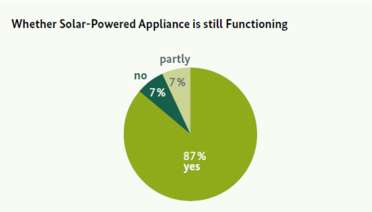Knowledge fuels change - Support energypedia!
For over 10 years, energypedia has been connecting energy experts around the world — helping them share knowledge, learn from each other, and accelerate the global energy transition.
Today, we ask for your support to keep this platform free and accessible to all.
Even a small contribution makes a big difference! If just 10–20% of our 60,000+ monthly visitors donated the equivalent of a cup of coffee — €5 — Energypedia would be fully funded for a whole year.
Is the knowledge you’ve gained through Energypedia this year worth €5 or more?
Your donation keeps the platform running, helps us create new knowledge products, and contributes directly to achieving SDG 7.
Thank you for your support, your donation, big or small, truly matters!
Promotion of Productive Use Appliances in Senegal through Results Based Financing
Promotion of Productive Use Appliances in Senegal through Results Based Financing
Project Approach
More than 20 % of Senegal’s population still lack access to electricity, and most of them live in rural areas. The Senegalese government aims to provide access to electricity for all of the country’s population by 2025, a goal that needs a massive effort to be achieved in just two years. As extending the electricity grid to remote areas is often prohibitively expensive, decentral renewable energy solutions play an important role in this effort.The intervention adopts a results-based financing (RBF) approach to incentivise solar companies to supply solar powered appliances for productive use of energy (PUE) in the region of Louga, far from the Dakar metropolitan area. In this department, known for its horticultural production, many farmers use diesel pumps to irrigate their fields. In addition, in the department of Saint Louis, shopkeepers are unable to sell iced water or fresh drinks and produce since they do not have access to electricity to cool these products. The GBE project therefore aims to promote the productive use of solar irrigation pumps and solar fridges.
The RBF mechanism works as follows:
- Contracted solar companies, in cooperation with an MFI, identify clients who want to purchase PUE appliances, mainly solar irrigation pumps.
- Clients pay a deposit of 10 % of the purchase price of the PUE appliance to the solar company
- The solar company receives 50 % of the price of the PUE appliance from GBE as an incentive payment once the solar device is installed at the client‘s premises and the installations have been verified and approved by GBE.
- The remaining 40 % is offered to the client by the solar company as a supplier credit, which is a precondition for participating in the programme
- The client has to pay the full price of the system, but only 10 % upfront, the remaining 90 % in instalments.
- The MFI assumes the payment claims of these instalments: The 50 % already paid to the solar company through the GBE incentive is collected by the MFI and used to replicate the financial mechanism for the purchase of additional PUE appliances for other clients.
The project also provides capacity building and awareness-raising support to end-users by providing advice and training on the maintenance and upkeep of solar systems, the profitability of their investments, the repayment of loans, and the provision and implementation of after-sales services by solar companies. Finally, training on organisational dynamics and management is also provided.
Methodology of Data Collection
The data for this case study report was collected through a review of project documents, five qualitative interviews with representatives of GIZ/GBE, the Senegalese Ministry of Energy, ANER, a solar company (Solene), a microfinance institution (MECZOP), and a quantitative survey of end-users with 18 respondents. The case study was conducted between February 2023 and May 2023. At that time, some project activities were still ongoing, and their impacts could not yet be fully captured.
Key Findings
Project Achievements
Forty-four farmers have so far been able to buy and install solar pumps (with a PV array capacity in the range of around 1 to 5 KWp) as a result of the intervention, replacing previously used diesel pumps, which have high fuel costs, require frequent maintenance and repair, and are more labour intensive to operate compared to solar systems. As shown in Figure 1, for about two- thirds of the farmers surveyed, the solar pumps have reduced energy costs, in most cases significantly.At the same time, almost half of the farmers surveyed have been able to increase the yield of their farms, as reflected in Figure 2. This can be attributed to the improvements in irrigation achieved by using solar pumps. With diesel pumps, farmers used to limit their irrigation to keep fuel costs down, which meant that insufficient amounts of water were applied to the crops, thereby limiting their growth. Although solar pumps have a lower flow rate than diesel pumps, farmers can use them more frequently without extra costs besides the investment costs. This allows the farmers to increase the overall amount of water applied to their crops, thereby optimizing crop growth. Moreover, since farmers no longer need to spend time in purchasing and transporting fuel, they are now able to devote more time to their farming activities and to ensure that the irrigation works well and is carried out more efficiently. The increased amount of irrigation water available has in some cases allowed farmers to extend their arable land, which has also contributed to an increase in agricultural yields.
In addition, the five shop owners, mainly women, who have bought solar fridges are now able to sell new products such as cold water, ice cream, fresh drinks, and chicken meat, thereby diversifying their business activities and improving the services they offer to their clients. Furthermore, farmers and shop owners have improved their management skills through training in dynamic, organisational and financial management. They are now able to manage more efficiently their businesses, for example, by allocating parts of the revenues to pay back loans, or to save for future investments in their businesses.
Intermediate Impact
By reducing energy costs and increasing agricultural productivity (see Figure 2), the intervention has substantially contributed to reducing the production costs of vegetables and cash crops and increasing incomes. Farmers have also confirmed that their income has become more stable throughout the year thanks to the improved availability of irrigation water during the dry season. For 46 % of the farmers and shop keepers surveyed, this has resulted in either a small or large increase in income, as shown in Figure 3. This has allowed them to invest in expanding their farmland and diversifying and intensifying their agricultural production. As stated by ANER, this has enabled them to create temporary jobs for family members or other people in the villages and improve their family’s living conditions. Furthermore, the substitution of diesel pumps eliminates the time and effort spent on purchasing and transporting fuel. This allows farmers to spend more time and energy on improving the productivity of their farms. Replacing fossil fuel pumps has also reduced air and noise pollution and avoids emissions of greenhouse gases. Thanks to the solar fridges and product diversification, shop owners have also increased their income by selling fresh drinks and produce, and generally diversifying their sales and services. They can also use the fridges to preserve products for their own consumption, avoiding food losses and maintaining food quality. The fact that customers pay the full purchase price avoids artificial market distortions and promotes the further development of the solar energy market in rural areas. The project has demonstrated the technical feasibility and practicality of the solar appliances, as well as their economic effectiveness.Finally, ANER, which has a mandate to promote the use of solar energy in rural areas in Senegal, has also benefited from GBE’s intervention by learning about new business cases for accelerating the use of solar energy in the country, and plans to apply a similar approach to the banana and rice value chains.
Challenges in Project Implementation
The implementation of the project has faced several challenges: First, there was a technical problem with the solar fridges, which took four days to produce ice. The end-users did not identify the technical issues, but confirmed that the solar fridges were working adequately afterwards. It seems likely that the difficulties experienced were due to initial over-loading of the fridges with goods which decreases their cooling capacity as it was experienced also in other GBE projects.Second, according to ANER, the intervention has generated considerable interest in solar PUE appliances, which it could only partially satisfy due to its limited scope and budget. This caused frustration on the part of those farmers who could not benefit from the support provided. Nevertheless, the GBE-intervention has demonstrated a financial model that could be used to continue promoting decentral renewable energy systems in the future.
Third, the targeted farmers are accustomed to repaying their loans only when they have harvested their crops and received the corresponding sales revenue. The project, therefore, had to raise awareness of the need for monthly repayments rather than repayments based on the harvest calendar. However, since the solar pumps allow for year-round production and multiple harvests, farmers have no difficulty in adapting to a more frequent repayment schedule.
Lessons Learned
The intervention has capitalised on the lessons learned and previous successes of GIZ’s EnDev and Sustainable Energy Programme (PED), which covered several rural areas in Senegal and supported the productive use of solar energy. This has enabled the intervention to better address the real needs of end-users and to make better decisions on the quality of solar appliances project organisation, and implementation approach. In contrast to EnDev and PED, which mainly financed the purchase of solar PUE appliances through grants, with the RBF mechanism, GBE adopted a market finance approach by creating an enabling environment for key stakeholders (MFIs, solar companies, end-users) to work together and prepare financial offers that integrate end-user needs.While the EnDev and PED approaches were relevant at the time to demonstrate the feasibility of solar PUE technology to create the willingness to pay amongst the end-users, the GBE approach focuses on further promoting solar PUE appliances and developing the solar energy market in Senegal. This market-based approach proved to have more potential for ensuring the sustainability of the intervention results and ultimately for further up-scaling of the results.
The project’s positive results are largely due to the strong interest of end-users in using solar energy for productive purposes and in receiving appropriate financing offers. The intervention has benefitted from the MFIs’ experience in working with farmers in remote rural areas to reach end-users, particularly in the agricultural sector. This has been strongly supported by ANER and the involvement of local authorities, traditional communities, and customary authorities, who have helped to raise awareness of the intervention, thereby attracting significant interest from potential end-users. Furthermore, ANER carried out quality checks on the solar appliances, validated their installation and is responsible for ensuring their proper operation and that maintenance is carried out by the solar companies, to ensure the functionality of the systems. The strong commitment and involvement of ANER has been a success factor and is also an important element for the up-scaling and replication of the intervention results, as well as for the sustainable use of the solar irrigation systems.
Sustainability of the Intervention
The RBF approach introduced by the GBE intervention is proving to be a sustainable model, since endusers can repay their loans under the offered conditions, as indicated by MESCOP. As a result, the approach is beneficial for both, MFIs and solar companies, which have signed agreements to continue working together to sell solar appliances beyond the GBE intervention. So far, 10 solar irrigation systems have been sold without the incentive program. The microfinance institution grants the client a loan of 30 % of the cost of the equipment and the company offers a supplier credit of 70 % repayable over 18 months. The incentive payment of 50 % of the price of the solar appliances is provided through a fund established by GBE. The fund is currently being used by the MFI and GBE to replicate and scale up the project results. The fund will be maintained and managed by the MFI, which collaborates will the supplier company to scale up the results and reach new clients. At the end of the GBE project, ANER will supervise the management of the fund and the process of multiplication.The after-sales service provided by the solar companies, with a two-year guarantee, has ensured regular monitoring of the solar appliances, thus contributing to the prevention of damage and the smooth operation and functioning of the solar pumps and fridges. It has also facilitated dialogue and the exchange of experience and knowledge between the solar companies and the end-users, helping the former to consider the challenges and the needs of their clients and the latter to gain substantial knowledge of solar technology. The direct contact between solar companies and end-users also allows the latter to contact solar company staff for advice on minor maintenance and to access maintenance and repair services when needed. The solar companies have been able to install several solar systems in the same region and will be able to cover them for the maintenance and after-sales, as the distances are small. Figure 4 shows that nearly 90 % of the solar appliances are still functioning.
Conclusion and Outlook
The intervention has capitalised on previous GIZ programmes to identify very well the real needs and challenges faced by the targeted end-users. The results- and market-based financing approach has contributed to the creation of a sustainable market for solar PUE appliances for the vegetable value chain in the Louga region and has brought together key stakeholders.
This approach is proof of RBF as successful stimulator for the solar market in rural regions. Based on the important previous interventions from EnDev and PED, raising awareness for PUE and creating willingness to pay amongst the end-users, the solar companies only needed medium-term support in form of incentives. Already before the end of the project, the solar companies were able to operate without financial incentives. In short, the intervention has demonstrated a real business case and business opportunities for solar energy in rural areas in Senegal, which are already being scaled up by the solar companies. In fact, ANER has already started designing a new project to massively scale up the intervention, targeting the needs of the banana and rice value chains.

